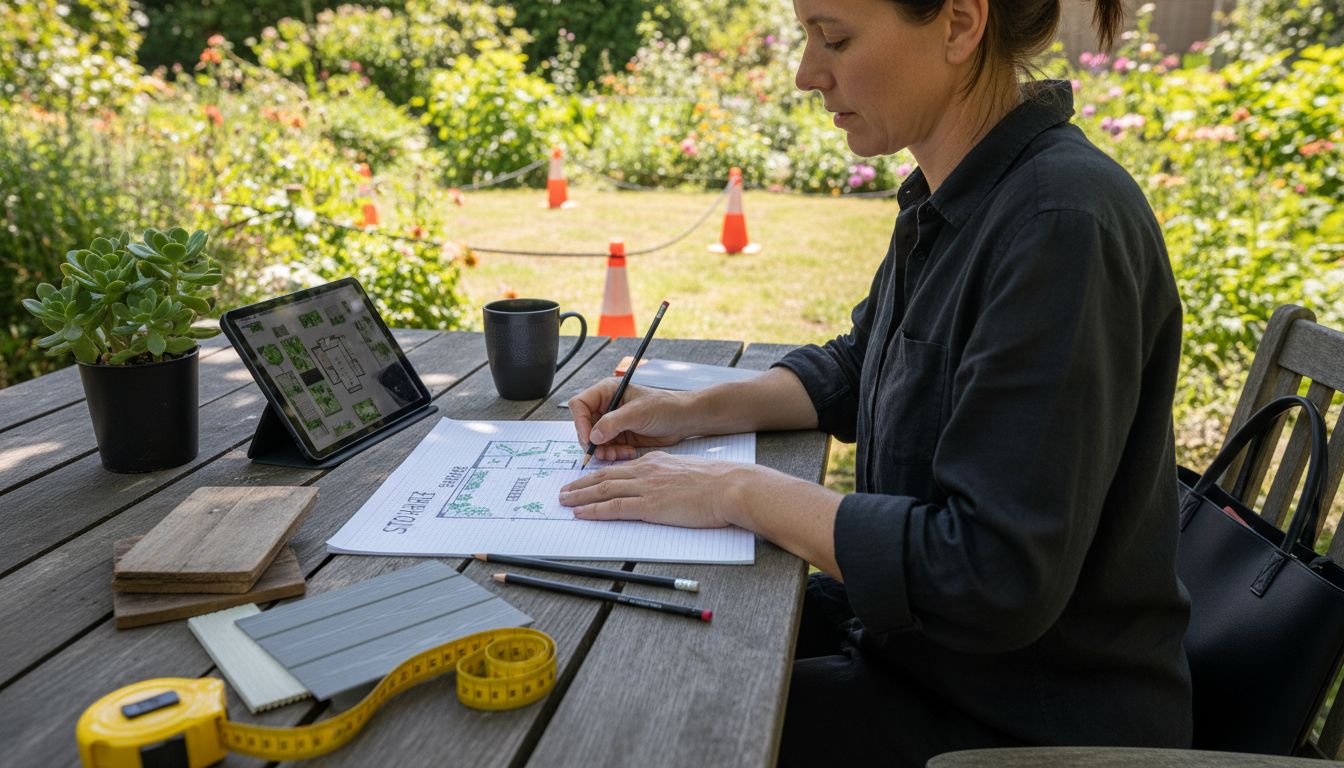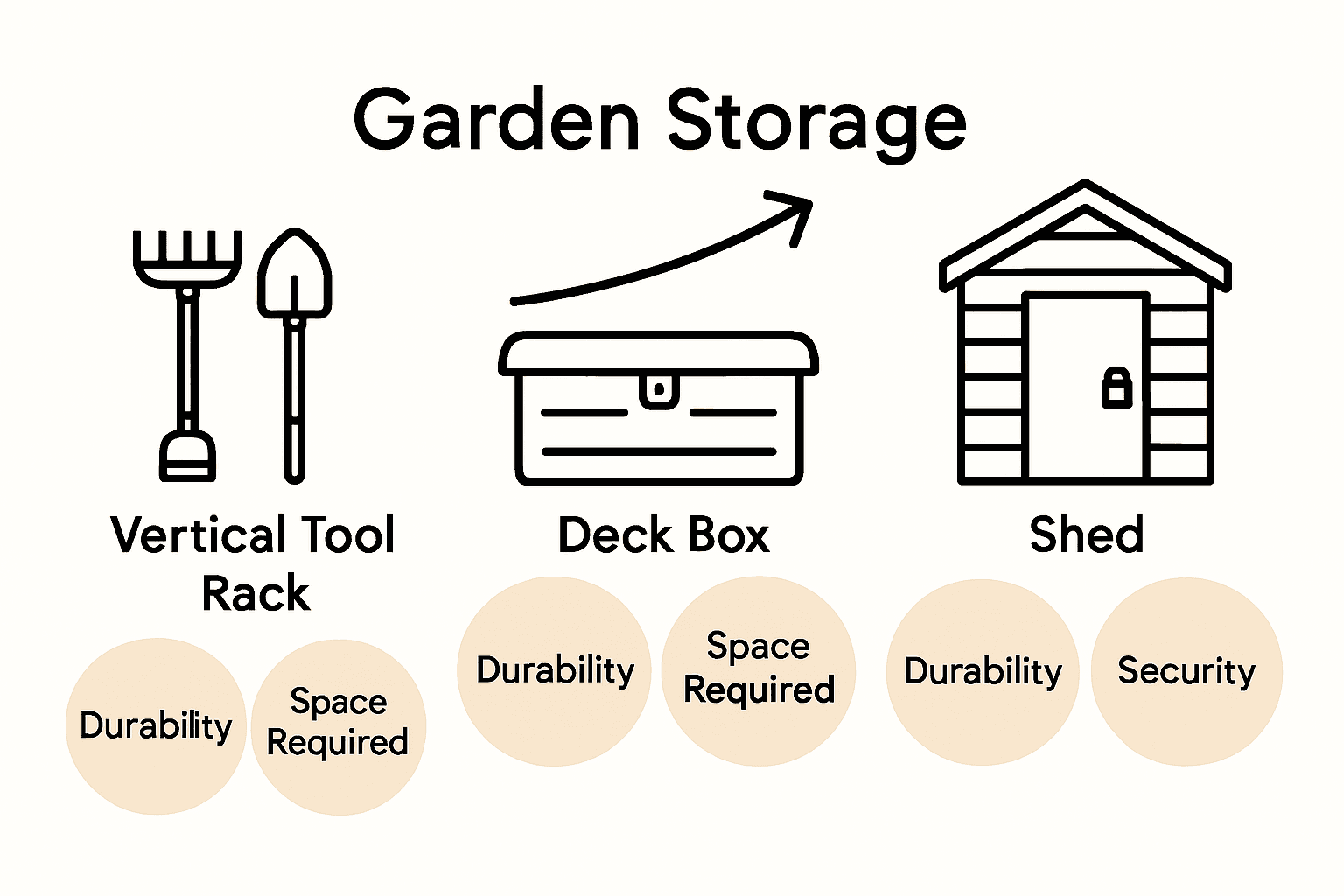Garden Storage Solutions Guide for Organised Outdoor Spaces

Over 60 percent of homeowners say clutter is their biggest garden frustration. Creating a tidy, efficient outdoor space matters not just for appearances but for making every gardening task easier and more enjoyable. By understanding exactly what your garden needs and how to organize it, you can reclaim order and protect your tools while finding solutions that truly fit your space.
Table of Contents
- Step 1: Assess Your Garden Storage Needs
- Step 2: Measure and Prepare Your Outdoor Space
- Step 3: Select Suitable Garden Storage Options
- Step 4: Install Your Chosen Garden Storage Solution
- Step 5: Organise and Secure Your Garden Items
- Step 6: Maintain and Review Your Storage Solution
Quick Summary
| Key Point | Explanation |
|---|---|
| 1. Assess your garden’s storage needs | Understand your garden’s unique characteristics to determine the best storage solutions for your space. |
| 2. Measure and prepare your outdoor area | Take precise measurements and create a detailed sketch to plan effective storage placement. |
| 3. Select suitable storage options | Choose storage that balances functionality, durability, and aesthetics to fit your garden’s needs. |
| 4. Install with precision | Follow proper installation procedures to ensure stability and longevity of your garden storage solution. |
| 5. Organize and secure items effectively | Implement a smart organizational system and security features to protect your garden tools and supplies. |
Step 1: Assess Your Garden Storage Needs
Successfully planning your garden storage starts with a thorough understanding of your unique outdoor space. This step involves carefully evaluating your garden’s specific characteristics to determine the most suitable storage solutions that will integrate seamlessly with your landscape.
According to Royal Horticultural Society, assessing your garden involves examining critical microclimate factors such as topography, shade patterns, and drainage conditions. Begin by walking through your garden and making detailed observations. Note areas that receive full sun, partial shade, or remain consistently damp. These insights will help you select storage solutions that can withstand your garden’s specific environmental conditions.
As Garden Organic recommends, consider your garden’s aspect and soil structure when planning storage. Measure the available space carefully, taking into account existing landscaping, pathways, and potential obstruction zones. Key aspects to assess include:
- Total available ground space
- Sunlight exposure throughout the day
- Proximity to garden beds or structures
- Ground levelness and potential drainage issues
- Accessibility for moving items in and out
Pro tip: Create a simple sketch or use a measuring tape to document your garden’s dimensions. This visual reference will prove invaluable when selecting storage solutions that fit perfectly within your outdoor space. Your next step will involve matching these assessed needs with appropriate storage options that complement your garden’s unique layout.
Step 2: Measure and Prepare Your Outdoor Space
Transforming your garden into an organised storage haven requires precise measurement and strategic preparation. This critical step will help you create a functional outdoor space that maximises efficiency and complements your existing landscape.
According to Royal Horticultural Society, understanding your garden thoroughly involves observing sunlight patterns and identifying key areas of potential storage placement. Begin by creating a detailed sketch of your outdoor space, marking out existing structures, garden beds, pathways, and potential storage zones. Use a measuring tape to capture precise dimensions, ensuring you record:
- Total available ground area
- Width and depth of potential storage locations
- Distances between existing garden features
- Clearance areas for movement and access
- Potential obstacles or uneven terrain
The Royal Horticultural Society recommends gathering inspiration from your current garden layout while planning potential improvements. Take time to walk through your outdoor space and visualise where storage solutions will integrate most seamlessly. Pro tip: Take photographs from multiple angles to help you later when selecting and positioning storage units.
 These visual references will prove invaluable in making informed decisions about the most suitable garden storage options. Your next step will involve selecting storage solutions that perfectly match the measurements and characteristics of your meticulously prepared outdoor space.
These visual references will prove invaluable in making informed decisions about the most suitable garden storage options. Your next step will involve selecting storage solutions that perfectly match the measurements and characteristics of your meticulously prepared outdoor space.
Step 3: Select Suitable Garden Storage Options
Choosing the right garden storage solution requires careful consideration of your specific needs, available space, and practical requirements. This crucial step will help you find storage options that not only meet your functional needs but also complement your outdoor aesthetic.
According to the Bedford Park Society, selecting appropriate storage involves thoughtful evaluation of dimensions and placement. When exploring storage options, consider these key factors:
- Material durability and weather resistance
- Size compatibility with your measured garden space
- Aesthetic alignment with existing garden design
- Accessibility and ease of use
- Potential for future expansion or modification
The HomeOwners Alliance recommends examining cost effectiveness alongside practical considerations. Look for storage solutions that offer the best balance between price, functionality, and long-term value. Pro tip: Consider modular or expandable storage systems that can adapt to your changing garden needs over time.
 These versatile options provide flexibility and can grow with your storage requirements. Your next step will involve carefully comparing different storage solutions to find the perfect match for your meticulously prepared outdoor space.
These versatile options provide flexibility and can grow with your storage requirements. Your next step will involve carefully comparing different storage solutions to find the perfect match for your meticulously prepared outdoor space.
Step 4: Install Your Chosen Garden Storage Solution
Successfully installing your garden storage solution requires careful planning, precise execution, and attention to detail. This critical step transforms your carefully selected storage option from a concept into a functional reality that enhances your outdoor space.
According to the Bedford Park Society, installation involves strategic placement and consideration of several key elements. Before beginning installation, gather all necessary tools and materials, and ensure you have:
- Appropriate foundation materials
- Correct measuring and levelling tools
- Protective gear for installation
- Necessary fasteners and fixings
- Assistance if handling larger storage units
The Institute of Kitchens, Bathrooms and Bedrooms recommends creating a solid preparation plan before starting. Pro tip: Take time to create a level base using appropriate materials like compacted gravel or concrete, which will ensure your storage solution remains stable and secure for years to come. Carefully follow manufacturer instructions, paying close attention to specific installation requirements for your chosen storage type.
Step 5: Organise and Secure Your Garden Items
Transforming your new garden storage solution into a well-organized and secure space requires strategic planning and thoughtful execution. This final step ensures your valuable garden tools, equipment, and supplies are not only neatly arranged but also protected from potential damage or theft.
According to the Institute of Kitchens, Bathrooms and Bedrooms, effective organization involves maximizing space efficiency and creating a logical storage system. Start by categorizing your items and investing in smart storage solutions:
- Adjustable shelving units
- Clear plastic containers with labels
- Hooks for hanging tools
- Stackable bins for smaller items
- Vertical storage systems to maximize space
The HomeOwners Alliance recommends considering security as a crucial aspect of item protection. Pro tip: Install additional locks, use weatherproof seals, and consider adding motion sensor lights to deter potential intruders. By implementing a comprehensive organization and security strategy, you will create a functional and safe storage environment that keeps your garden items accessible and well protected. Your garden storage journey is now complete, providing you with an efficient and organized outdoor solution.
Step 6: Maintain and Review Your Storage Solution
Maintaining an effective garden storage solution requires periodic assessment and proactive care. This crucial ongoing process ensures your storage remains functional, secure, and aligned with your evolving garden needs.
According to the Royal Horticultural Society, regularly evaluating your garden’s microclimate is essential for preserving your storage infrastructure. Conduct a comprehensive review of your storage solution at least twice annually, focusing on:
- Structural integrity
- Weather damage assessment
- Organizational effectiveness
- Security feature functionality
- Item inventory management
Garden Organic recommends continuous space assessment to adapt storage solutions dynamically. Pro tip: Create a maintenance schedule that includes cleaning, checking for potential repairs, and reorganizing items to prevent clutter buildup. By implementing a systematic review process, you will ensure your garden storage solution remains an efficient and reliable asset that grows and changes with your gardening needs. Your storage solution is now a living system that requires ongoing attention and care.
Create Your Perfect Garden Storage Solution Today
Tackling the challenge of finding garden storage that fits your unique space and style can feel overwhelming. You have carefully measured your outdoor area and identified vital needs like durability, accessibility and smart organisation. Now imagine transforming that vision into reality with bespoke garden buildings tailored exactly to your requirements. At Log Cabin Kits, we understand how important it is to have storage solutions that not only protect your items but also enhance your garden’s beauty and functionality.

Explore our range of customisable garden storage options designed to fit your measured space perfectly and withstand the British weather year after year. Don’t wait to enjoy the peace of mind from a well-organised and secure garden store. Visit Log Cabin Kits now to browse our collections and discover how easy it is to create your ideal outdoor storage. Your organised garden oasis is just a click away.
Frequently Asked Questions
To assess your garden storage needs, walk through your outdoor space and evaluate its characteristics, such as sunlight exposure and drainage conditions. Take notes on areas that receive varying degrees of sun and moisture, which will help inform your storage options.
Before selecting garden storage, measure the total ground area available, including the width and depth of potential storage locations. Record distances from existing structures to ensure that your chosen solution fits comfortably within the designated space.
When selecting garden storage options, consider material durability, size compatibility, and aesthetic alignment with your garden. Ensure that the chosen solution is accessible and functional for your specific needs, and keep long-term growth in mind for your storage capacity.
To install your garden storage solution, ensure you have all necessary tools and materials, including foundation materials and fasteners. Create a level base using materials like gravel or concrete, and follow manufacturer instructions carefully during installation.
Organise items in your garden storage by categorizing them and using storage solutions like adjustable shelving, labeled containers, and hooks for hanging tools. This approach will help maximize space and make it easier to find what you need when working in your garden.
Review and maintain your garden storage solution at least twice a year to assess its structural integrity and organization. Create a maintenance schedule to clean, check for repairs, and reorganize items to prevent clutter buildup over time.
